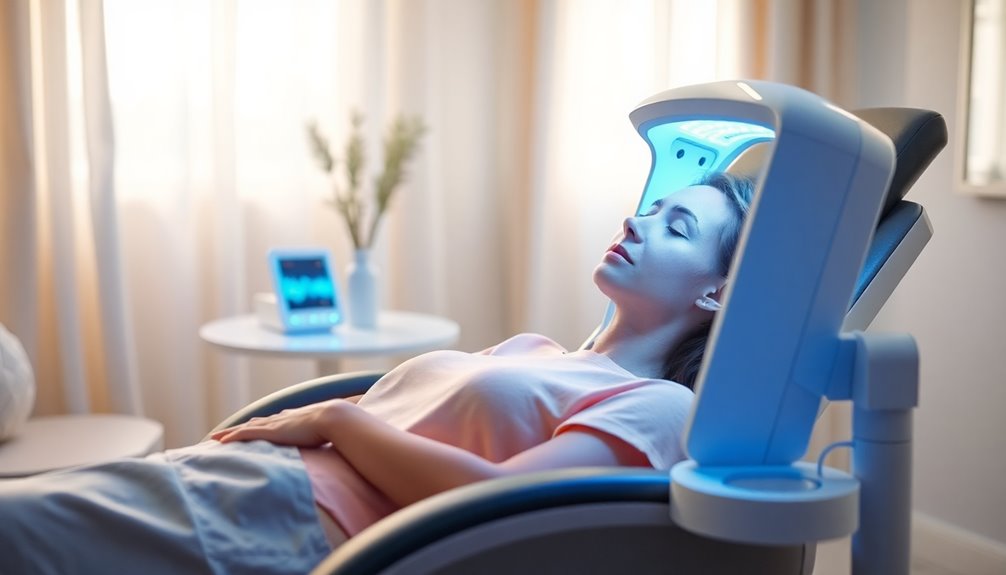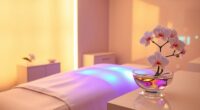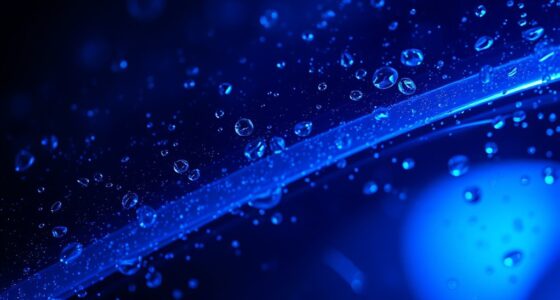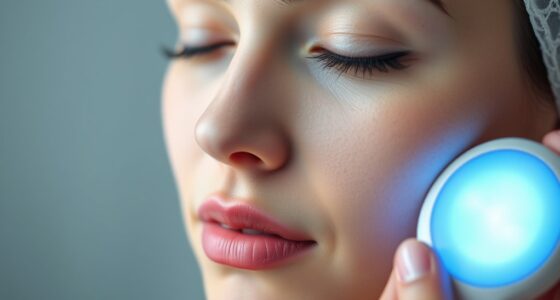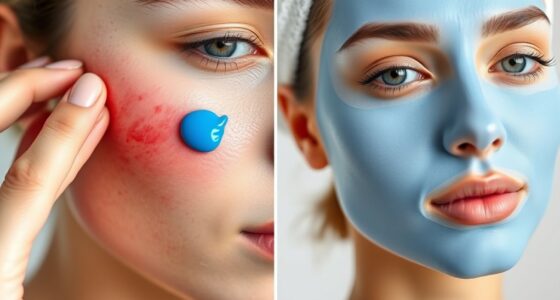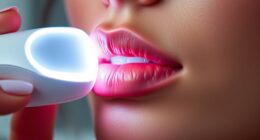Blue light therapy is effective for treating rosacea, helping reduce redness and inflammation. Patients aged 18-76 often report good results, especially when using wavelengths between 453 nm and 480 nm. This therapy works by generating reactive oxygen species to combat the bacteria responsible for flare-ups and has minimal side effects. You might notice improved skin condition with regular treatments, especially when combined with red light therapy. While outcomes can vary, many experience substantial improvements. If you're curious about how this treatment can fit into your skincare routine, you'll find more insights ahead.
Key Takeaways
- Blue light therapy has clinical evidence supporting its effectiveness in treating rosacea, particularly for reducing inflammation and redness.
- Patients aged 18-76 report satisfactory responses, with varying degrees of improvement in symptoms.
- Combining blue light with red light therapy may enhance overall treatment effectiveness and skin condition.
- While immediate side effects include temporary redness, long-term risks are minimal, with no lasting damage expected.
- Regular use of blue light therapy correlates with sustained benefits in managing rosacea symptoms.
Efficacy of Blue Light Therapy
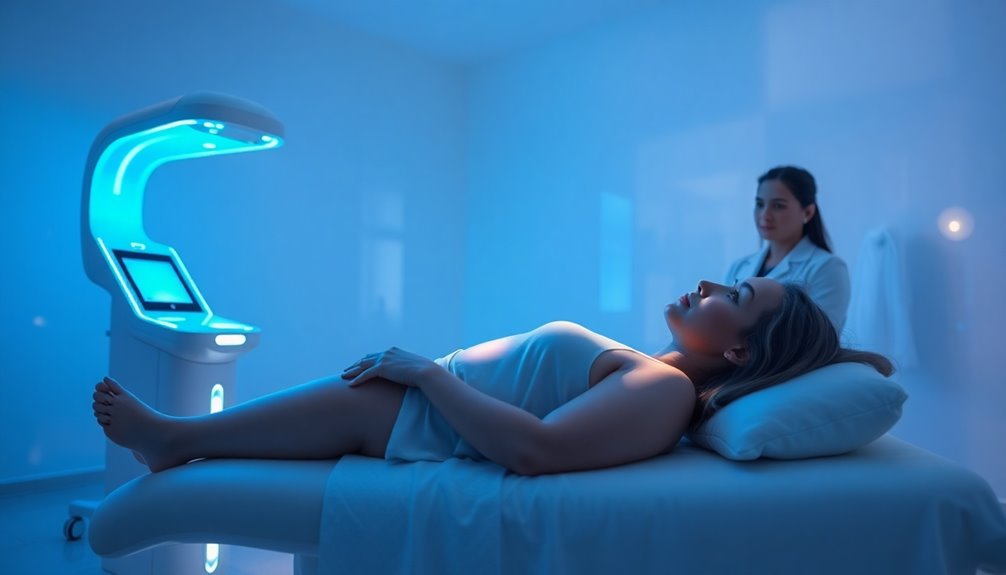
Although blue light therapy is relatively new in the treatment of rosacea, clinical evidence supports its efficacy in improving symptoms. Research shows that patients aged 18 to 76 have experienced satisfactory clinical responses, with some reporting significant improvements. Studies utilizing blue light wavelengths of 453 nm and 480 nm demonstrate anti-inflammatory effects, especially when combined with photosensitizers like methyl aminolevulinate (MAL). Higher intensities and longer treatment durations yield better outcomes, often reducing symptoms like erythema and scaling. Additionally, combining blue light with red light therapy may enhance effectiveness. Notably, Demodex mites are linked to exacerbating symptoms in some individuals, indicating that blue light therapy could be part of a comprehensive treatment strategy. Overall, blue light therapy not only improves skin condition but also boosts quality of life, making it a promising option for those struggling with rosacea.
Safety Considerations
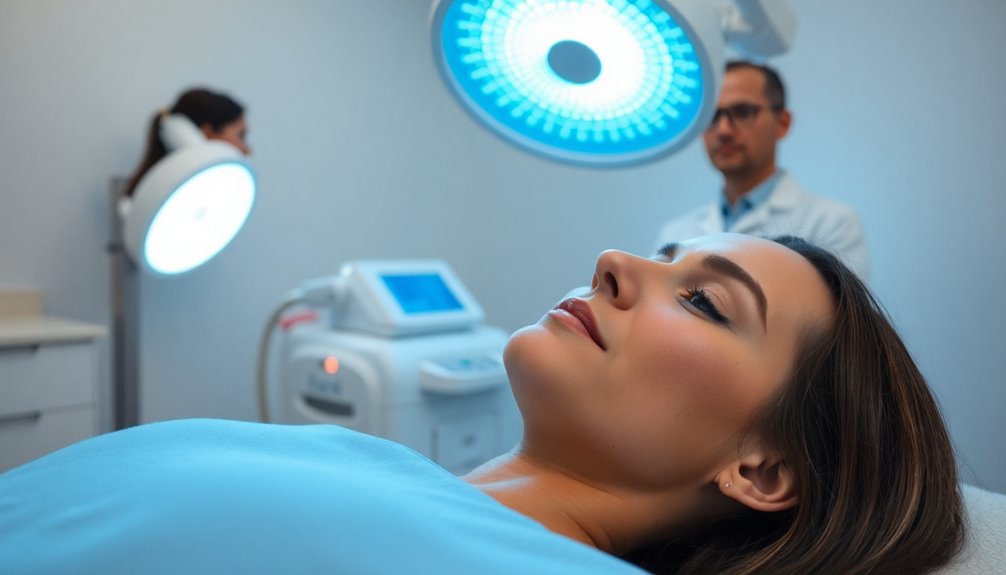
When considering blue light therapy for rosacea, it's essential to be aware of the safety considerations involved. You might experience immediate side effects like temporary redness, mild swelling, or increased sensitivity to sunlight. Mild discomfort is also common but usually resolves quickly. Long-term risks are minimal, with no scarring or lasting damage expected, provided the treatment is administered correctly. However, certain conditions like porphyria, lupus, or skin infections could complicate your therapy, so make sure to discuss your medical history with your doctor. After treatment, avoid bright light and follow your doctor's post-care instructions, including the use of sunscreen. Monitoring for complications like hyperpigmentation is crucial to ensure a safe experience.
Patient Experiences and Outcomes
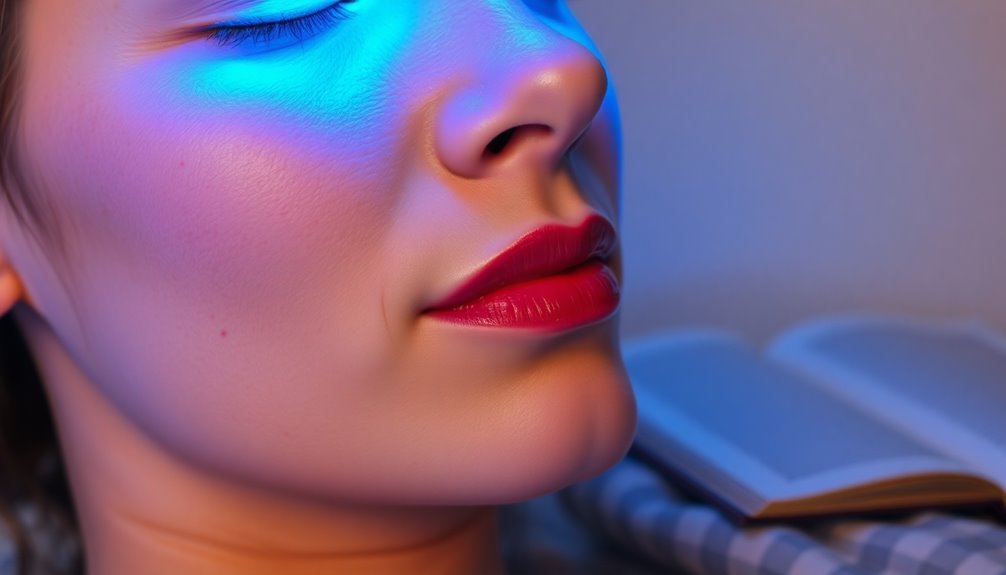
How effective is blue light therapy for rosacea? Many patients report positive outcomes, noting a reduction in facial redness and inflammation.
While some see substantial improvements, others experience only slight changes, highlighting that results can vary. Regular use seems crucial; those who incorporate blue light therapy into their daily routine often enjoy sustained benefits. Additionally, the use of red light therapy has been shown to reduce inflammation across all rosacea subtypes, making it a complementary option.
Combining blue light with other wavelengths, like red or green light, may enhance results further. Plus, patients appreciate its ease of use and minimal side effects.
Some even find pain relief, especially those dealing with papulopustular rosacea. Overall, blue light therapy can be a beneficial component of your skincare regimen, promoting skin health and helping manage rosacea symptoms effectively. In addition to blue light therapy, many individuals are also exploring the green light therapy benefits for their skin conditions. Green light therapy is known for its soothing properties, which can further reduce redness and promote an even skin tone. By incorporating both types of light therapy into their routines, users may experience enhanced results and improved overall skin vitality.
Mechanism of Action
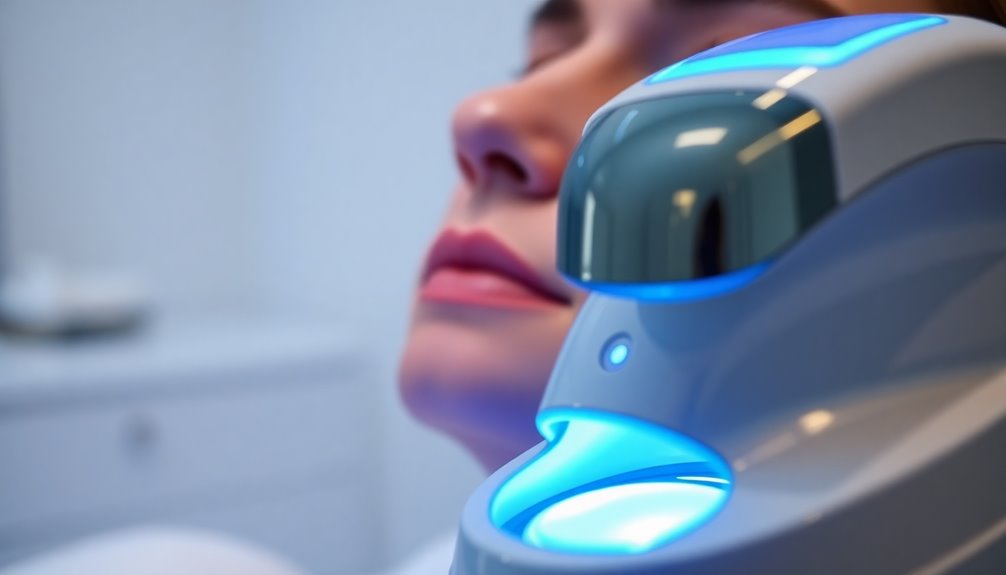
Patients who've experienced positive outcomes with blue light therapy for rosacea might wonder about the science behind its effectiveness.
This therapy primarily works through its anti-inflammatory effects, reducing cytokine production and inhibiting keratinization. It also destroys bacteria, specifically *Cutibacterium acnes*, by generating reactive oxygen species, which helps to decrease sebum secretion.
The blue light penetrates about 0.3 mm into the skin, effectively targeting the epidermis to limit sebocyte proliferation.
Additionally, combining blue light with red light enhances its impact, improving skin condition and elasticity while reducing inflammation. Recent studies show that this combination therapy yields superior results compared to single-modality treatments.
Research and Evidence
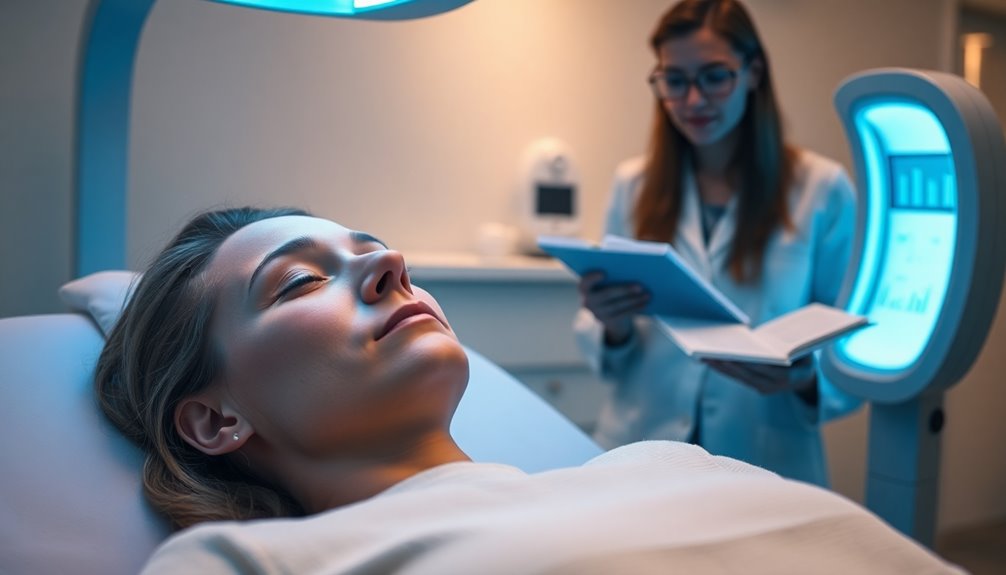
Research into blue light therapy for rosacea has revealed promising findings that support its efficacy. Clinical studies indicate that combining blue and red light effectively reduces rosacea symptoms.
A systematic review of nine studies on photodynamic therapy (PDT) shows a satisfactory clinical response. The 400–470 nm blue light specifically targets epidermal skin conditions, including rosacea.
You'll find that patients with papulopustular rosacea often experience improvement using blue and red light therapies, with most side effects being temporary and well-tolerated. Additionally, new prescription therapies have been developed that can complement light therapy for better results.
Compared to other treatments like intense pulsed light, blue light therapy proves effective and safer when combined with red light.
Future research should focus on rigorous randomized control trials to further validate these findings and optimize treatment schedules.
Frequently Asked Questions
How Long Does a Typical Blue Light Therapy Session Last?
A typical blue light therapy session lasts between 15 to 30 minutes when you visit a dermatologist.
These in-office sessions are more intense than at-home treatments, so they require less time.
You'll likely need 2-3 sessions per week for about 4-6 weeks to see optimal results.
If you opt for at-home devices, session duration may vary, but consistency is key for managing acne and inflammation effectively.
Can Blue Light Therapy Be Combined With Other Skin Treatments?
Yes, you can definitely combine blue light therapy with other skin treatments for enhanced results.
Pairing it with red light therapy targets both inflammation and sebum production effectively.
You can also use it alongside anti-inflammatory agents or skincare products containing BHAs to reduce blocked pores and bacterial growth.
This combination approach is tailored to your specific skin needs, making it a versatile and safe option for improving your skin health.
Is Blue Light Therapy Suitable for All Skin Types?
Imagine a garden where every flower, regardless of its color or size, thrives under the same gentle sunlight.
Just like that, Blue Light Therapy suits all skin types, from the fairest petals to the deepest hues. It's non-invasive and works beautifully, stimulating collagen and targeting bacteria without harm.
Whether you've got a suntan or sensitive skin, this versatile treatment embraces all, allowing your skin to bloom with health and vitality.
How Much Does Blue Light Therapy Cost on Average?
On average, blue light therapy sessions cost between $300 and $500.
You might find session prices ranging from $40 to $1,500, depending on the severity of your symptoms and how many sessions you need.
Most people require about 4 to 6 sessions, often weekly, to see results.
If you're concerned about costs, check if your insurance offers any coverage, which could lower your expenses significantly.
Are There Any At-Home Blue Light Therapy Devices Recommended?
Wondering if you can achieve glowing skin from the comfort of home? At-home blue light therapy devices are a fantastic option.
They're convenient and can help you maintain results without breaking the bank. While they're less intense than professional treatments, using them 2-3 times a week for 10-20 minutes can lead to noticeable improvements.
Just remember to prep your skin properly, and you'll be on your way to clearer, healthier skin.
Conclusion
In conclusion, blue light therapy can be an effective option for managing rosacea, with studies showing that about 70% of patients experience significant improvement in their symptoms. While safety considerations are important, many find this treatment to be a game-changer. As you explore options for rosacea management, keep in mind the positive patient experiences and the promising research backing this therapy. It might just be the solution you've been searching for!
